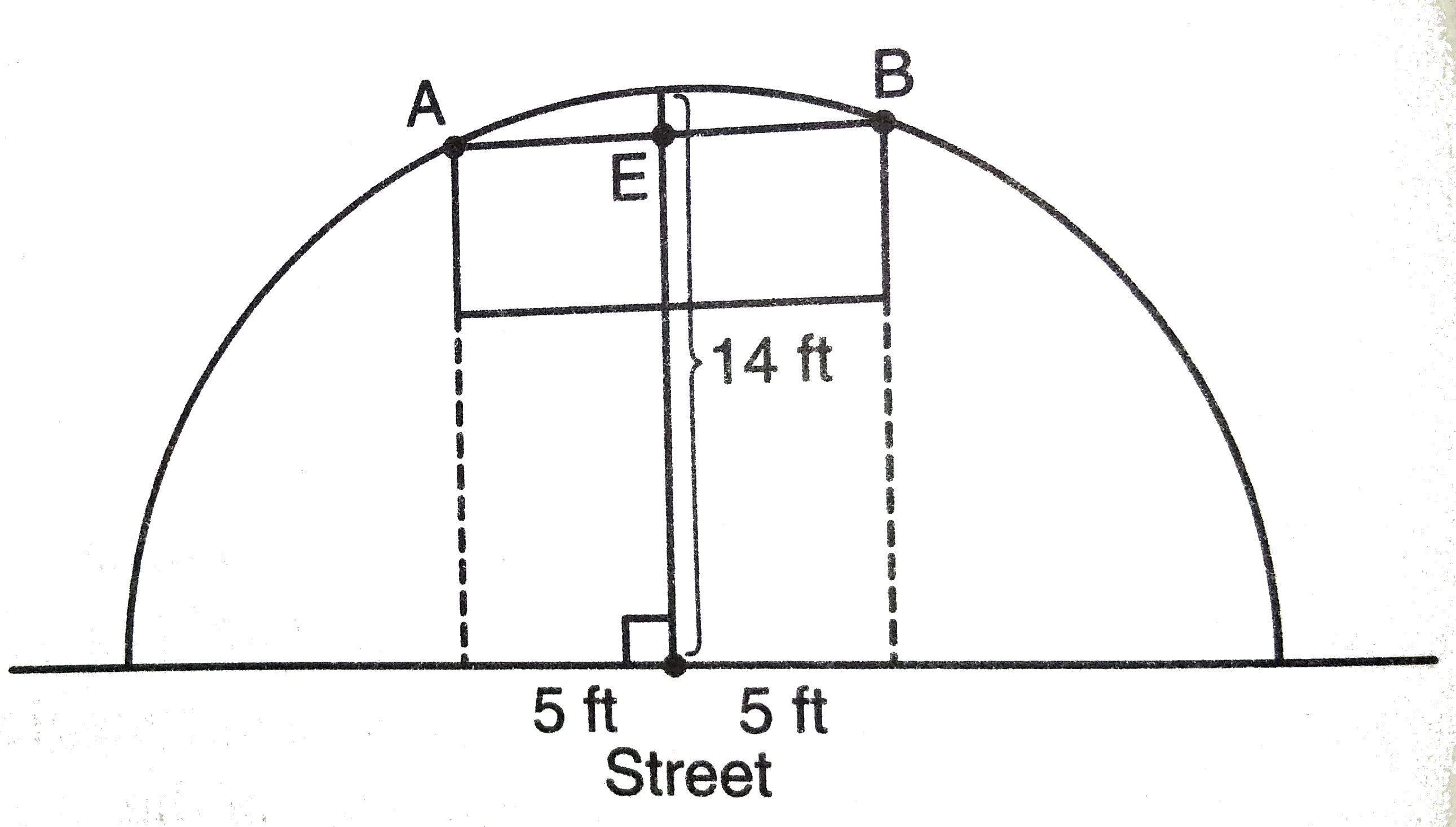
The diagram above shows a semicircular arch over a street that has a radius of 14 feet. A banner is attached to the arch at points A and B, such that AE=EB=5 feets. How many feet above the ground are these points of attachment for the banner, correct to the nearest tenth of a foot?
The correct Answer is:13.1
Step by step video, text & image solution for The diagram above shows a semicircular arch over a street that has a radius of 14 feet. A banner is attached to the arch at points A and B, such that AE=EB=5 feets. How many feet above the ground are these points of attachment for the banner, correct to the nearest tenth of a foot? by Maths experts to help you in doubts & scoring excellent marks in Class 12 exams.
Topper's Solved these Questions
- BOOK - ENGLISH SATCHAPTER - ADDITIONAL TOPICS IN MATHEXERCISE - EXERCISE45videos
ADDITIONAL TOPICS IN MATH
- BOOK - ENGLISH SATCHAPTER - ADDITIONAL TOPICS IN MATHEXERCISE - Multiple Choice99videos
ADDITIONAL TOPICS IN MATH
- BOOK - ENGLISH SATCHAPTER - ADDITIONAL TOPICS IN MATH EXERCISE - PRACTICE TEST24videos
ADDITIONAL TOPICS IN MATH
- BOOK - ENGLISH SATCHAPTER - COMPLEX NUMBERSEXERCISE - EXERCISE6videos
COMPLEX NUMBERS
Similar Questions
For Question 4 and 5 refer to the diagram

A flagpole that stands on level ground. Two cables, r and s, are attached to the pole at a point 12 feet above the ground and form a right angle with each other. Cable r is attached to the ground to the ground at a point that makes tanx=0.75.
Q. What is the sum of the lengths of cables r and s?View SolutionFor Question 4 and 5 refer to the diagram
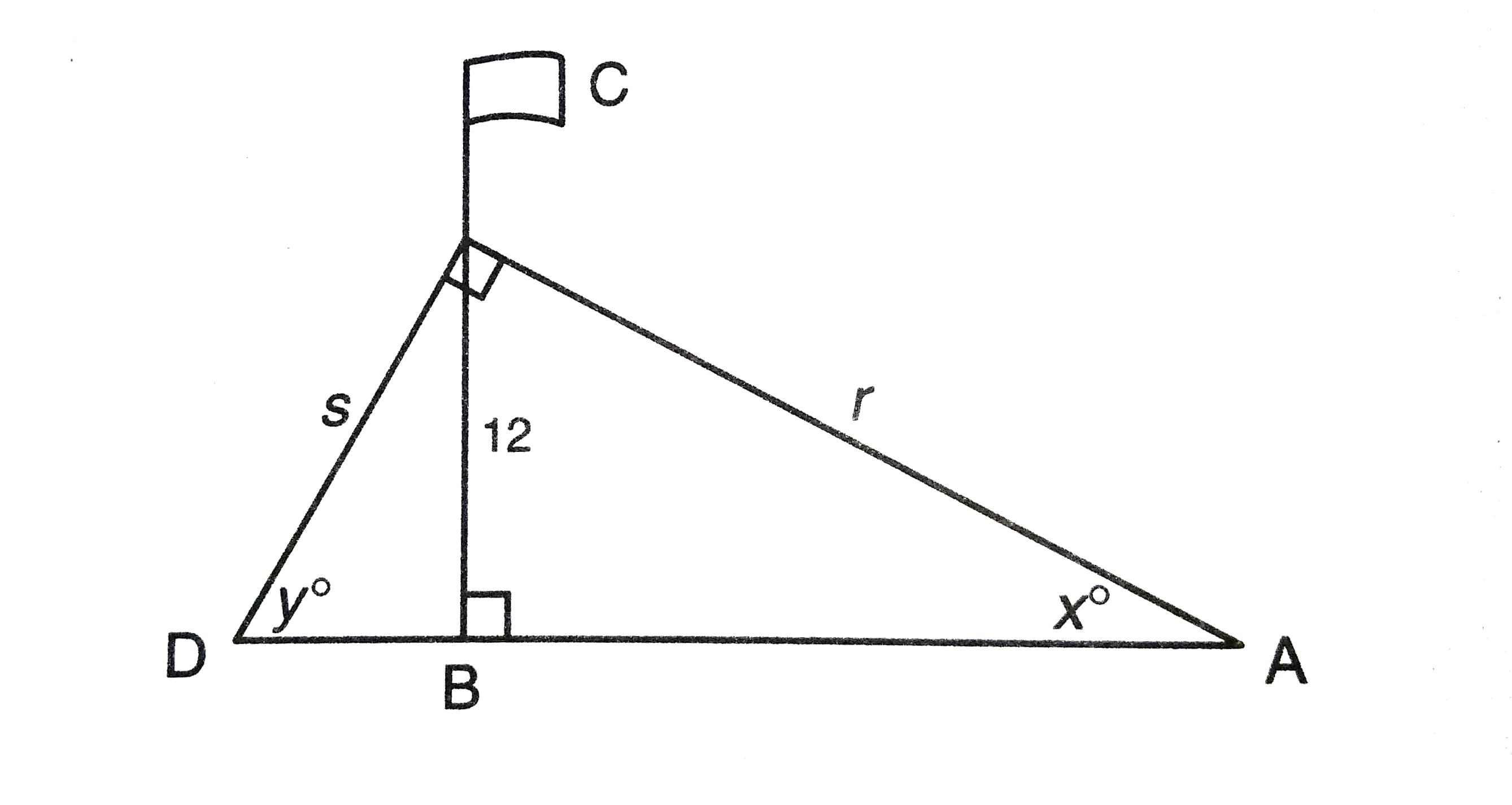
A flagpole that stands on level ground. Two cables, r and s, are attached to the pole at a point 12 feet above the ground and form a right angle with each other. Cable r is attached to the ground to the ground at a point that makes tanx=0.75.
Q. What is the value of cosx?View Solution
Knowledge Check
- Question 1 - Select One
As shown in the figure below, Tony has determined that he must ride his skateboard down a long ramp to be able to jump a shorter ramp with enough time to complete a new trick. First, he needs to determine the dimensions of both the shorter and longer ramps. Tony is on his skateboard at point K, 20 feet above the ground . He then notes that the vertical height ¯¯¯¯¯¯HJ of the shorter ramp is 6 feet above the ground, and the length of the shorter ramp ¯¯¯¯¯¯GJ is 9 feet. Approximately how many feet long is the longer ramp ?
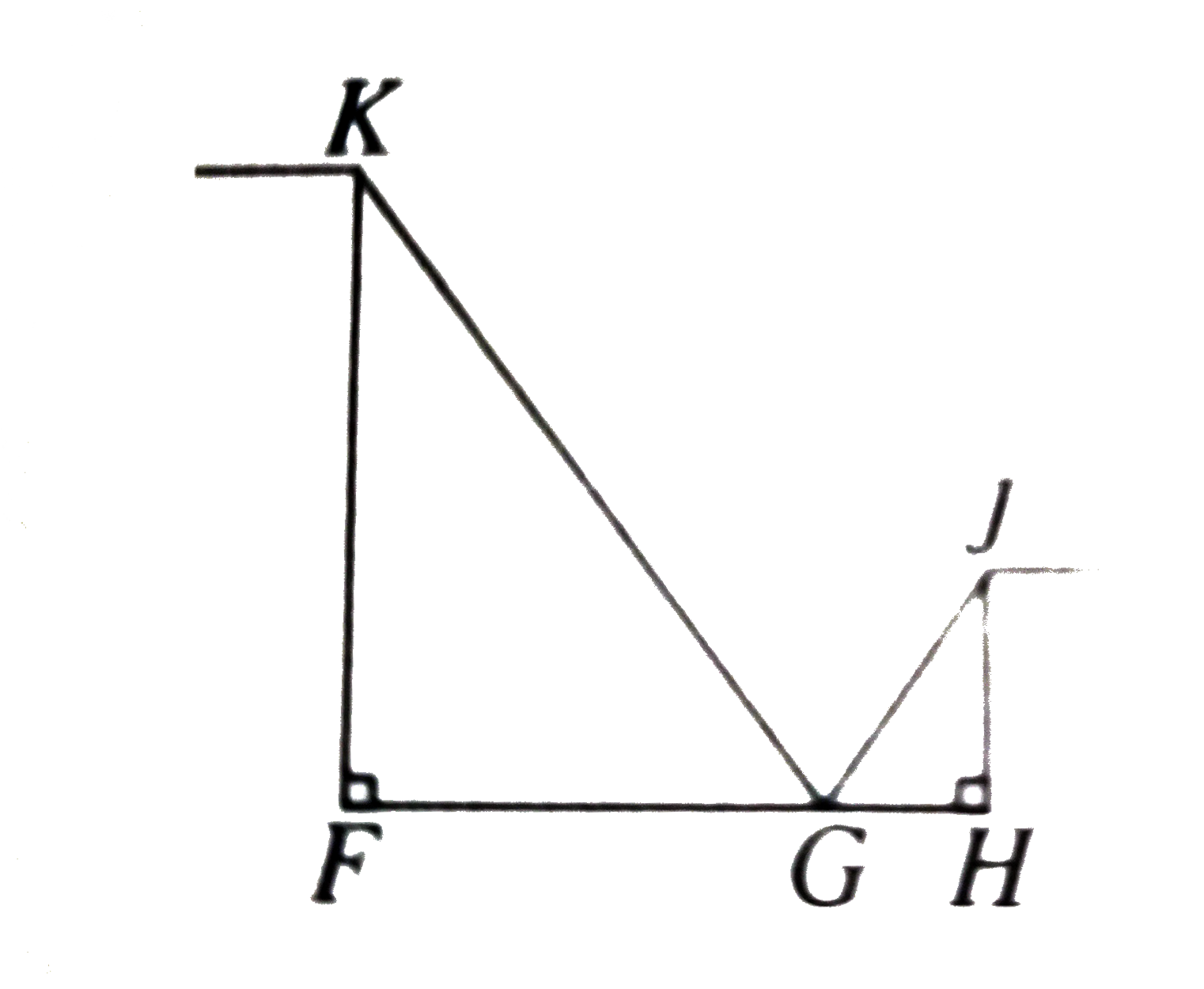 A3B12C15D30
A3B12C15D30 - Question 2 - Select One
A graduation cap is tossed upward . It is f feet above the ground s seconds after it has been thown . The relation ship between f and s is given by the equation f=60s−17s2, where 0≤s≤3.5 . How many feet above the ground is the cap 3 seconds after it is thrown ?
A27B41C60D80 - Question 3 - Select One
The chemical formula of deoxyribonucleic acid
(DNA) is now well established. The molecule is a
very long chain, the backbone of which consists of a
regular alternation of sugar and phosphate groups.
5 To each sugar is attached a nitrogenous base, which
can be of four different types. Two of the possible
bases—adenine and guanine—are purines, and the
other two—thymine and cytosine—are pyrimidines.
So far as is known, the sequence of bases along the
10 chain is irregular. The monomer unit, consisting of
phosphate, sugar and base, is known as a nucleotide.
The first feature of our structure which is of
biological interest is that it consists not of one chain,
but of two. These two chains are both coiled around
15 a common fiber axis. It has often been assumed that
since there was only one chain in the chemical
formula there would only be one in the structural
unit. However, the density, taken with the X-ray
evidence, suggests very strongly that there are two.
20. The other biologically important feature is the
manner in which the two chains are held together.
This is done by hydrogen bonds between the bases.
The bases are joined together in pairs, a single base
from one chain being hydrogen-bonded to a single
25 base from the other. The important point is that only
certain pairs of bases will fit into the structure.
One member of a pair must be a purine and the other
a pyrimidine in order to bridge between the two
chains. If a pair consisted of two purines, for
30 example, there would not be room for it.
We believe that the bases will be present almost
entirely in their most probable forms. If this is true,
the conditions for forming hydrogen bonds are more
restrictive, and the only pairs of bases possible are:
35 adenine with thymine, and guanine with cytosine.
Adenine, for example, can occur on either chain, but
when it does, its partner on the other chain must
always be thymine.
The phosphate-sugar backbone of our model is
40 completely regular, but any sequence of the pairs of
bases can fit into the structure. It follows that in a
long molecule many different permutations are
possible, and it therefore seems likely that the precise
sequence of bases is the code which carries the
45 genetical information. If the actual order of the bases
on one of the pair of chains were given, one could
write down the exact order of the bases on the other
one, because of the specific pairing. Thus one chain
is, as it were, the complement of the other, and it is
50 this feature which suggests how the deoxyribonucleic
acid molecule might duplicate itself.
The table shows, for various organisms, the percentage of
each of the four types of nitrogenous bases in that
organism’s DNA.
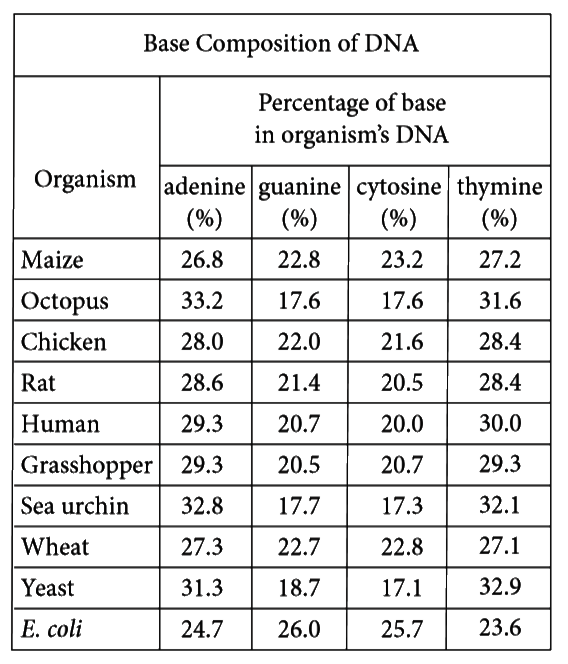
Adapted from Manju Bansal, “DNA Structure: Revisiting the
Watson-Crick Double Helix.” ©2003 by Current Science Association,
Bangalore
29. Do the data in the table support the authors’ proposed pairing of bases in DNA?AYes, because for each given organism, the percentage of adenine is closest to the percentage of thymine, and the percentage of guanine is closest to the percentage of cytosine.BYes, because for each given organism, the percentage of adenine is closest to the percentage of guanine, and the percentage of cytosine is closest to the percentage of thymine.CNo, because for each given organism, the percentage of adenine is closest to the percentage of thymine, and the percentage of guanine is closest to the percentage of cytosine.DNo, because for each given organism, the percentage of adenine is closest to the percentage of guanine, and the percentage of cytosine is closest to the percentage of thymine.
Jane has to point a cylindrical column that is 14 feet high and that has a circular base with a radius of 3 feet. If one bucket of paint will cover 10π square feet, how many whole buckets does jane need to buy in order to paint the column, including the top and bottom?
View Solution
A lawn sprinkler sprays water in a circular pattern at a distance of 15 feet from the sprinkler head which rotates through the angle of 5π3 radians, as shown by the shaded area in the diagram above. What is the area of the lawn, to the nearest square foot, that recieves water from this sprinkler?View SolutionA water hose pipe of cross-sectional area 5cm2 is used to fill a tank of 120L. It has been observed that it takes 2 min to fill the tank. Now, a nozzel with an opening of cross-sectional area 1cm2 is attached to the hose. The nozzel is held so that water is projected horizontally from a point 1m above the ground. The horizontal distance over which the water can be projected is (Take g=10m/s2).
View SolutionWith reference to the given figure, a man stands on the ground at point A, Which is on the same horizontal plane as B, the foot of the vertical pole BC. The height of the pole is 10 m . The man's eye is 2 m above the ground. He observes the angle of elevation of C, the top of the pole, as x∘ , where tan x∘=25 . Calculate :
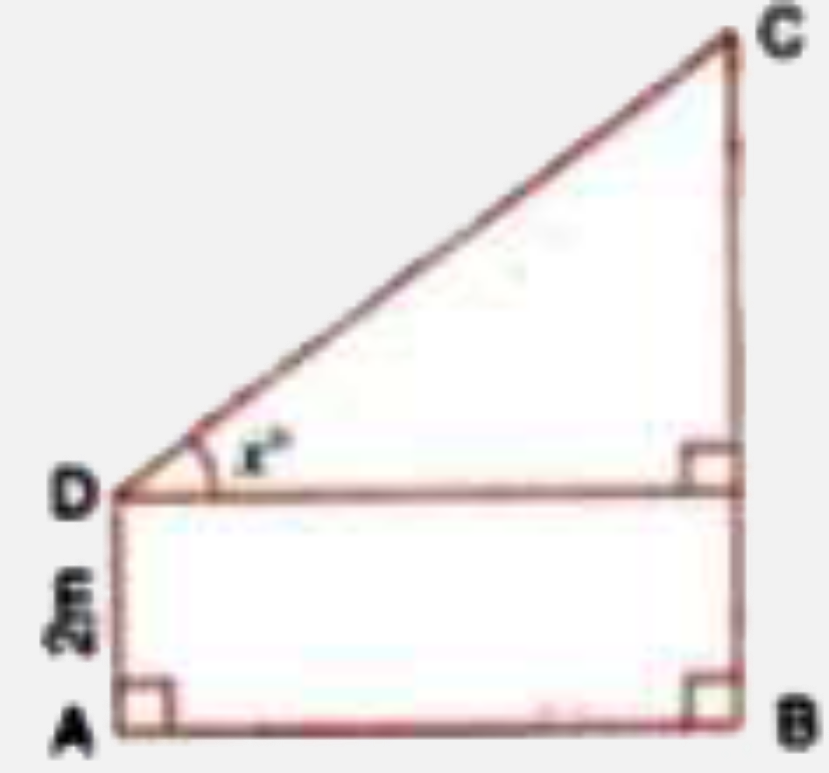
angle of elevation of the top of the pole when he is standing 15 metres from the pole. Give your answer to the nearest degree.View SolutionAn unmanned satellite A and a spacecraft B are orbiting around the earth in the same circular orbit as shown.
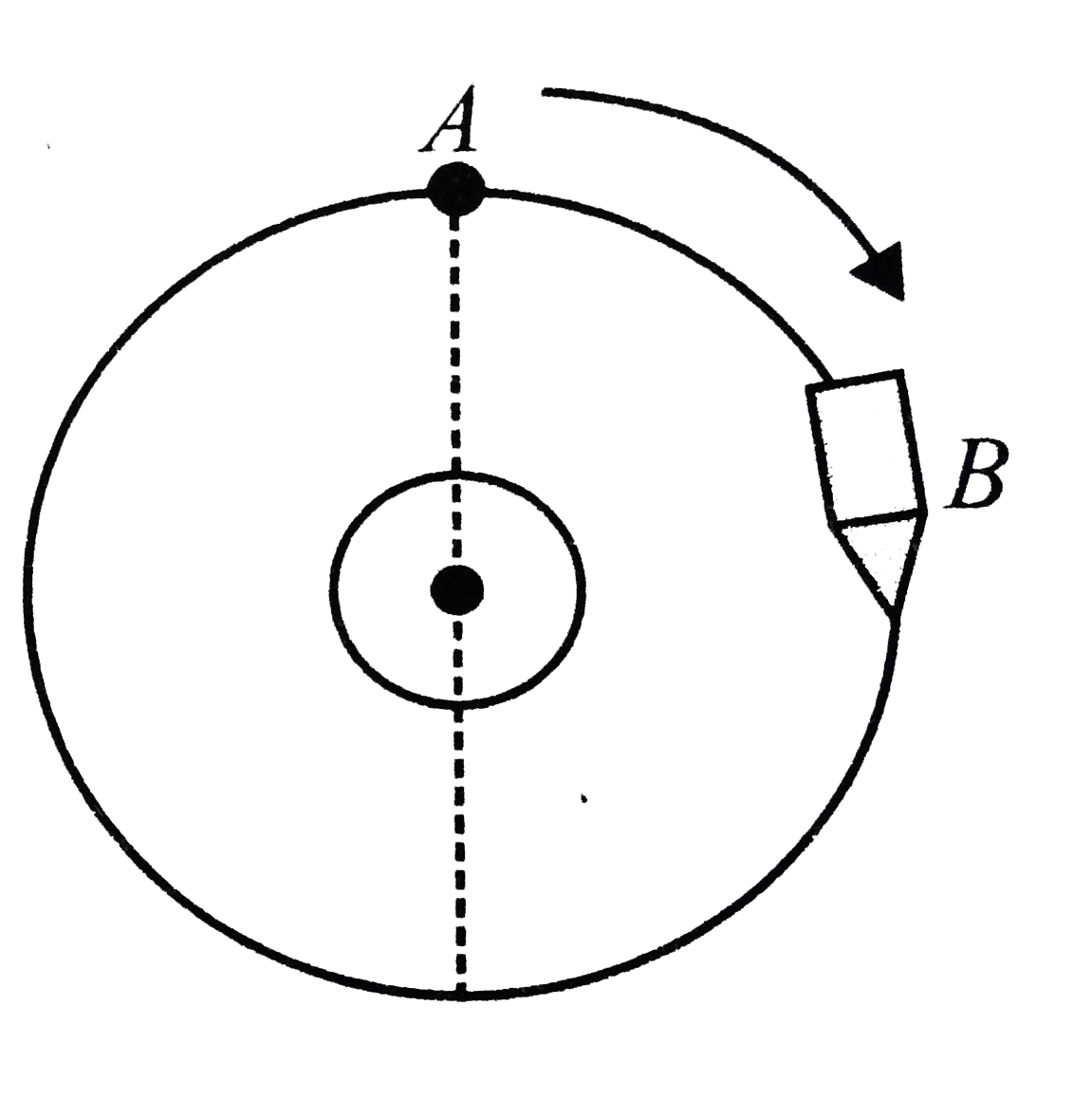 The spacecraft is ahead of the satellite by some time. Let us consider that some technical problem has arisen in the satellite and the astronaut from B has made it correct. For this to be done docking of two (A and B) is required (in layman terms connecting A and B). To achieve this, the rockets of A have been fired in forward direction and docking takes place as shown in the figure below:
The spacecraft is ahead of the satellite by some time. Let us consider that some technical problem has arisen in the satellite and the astronaut from B has made it correct. For this to be done docking of two (A and B) is required (in layman terms connecting A and B). To achieve this, the rockets of A have been fired in forward direction and docking takes place as shown in the figure below:
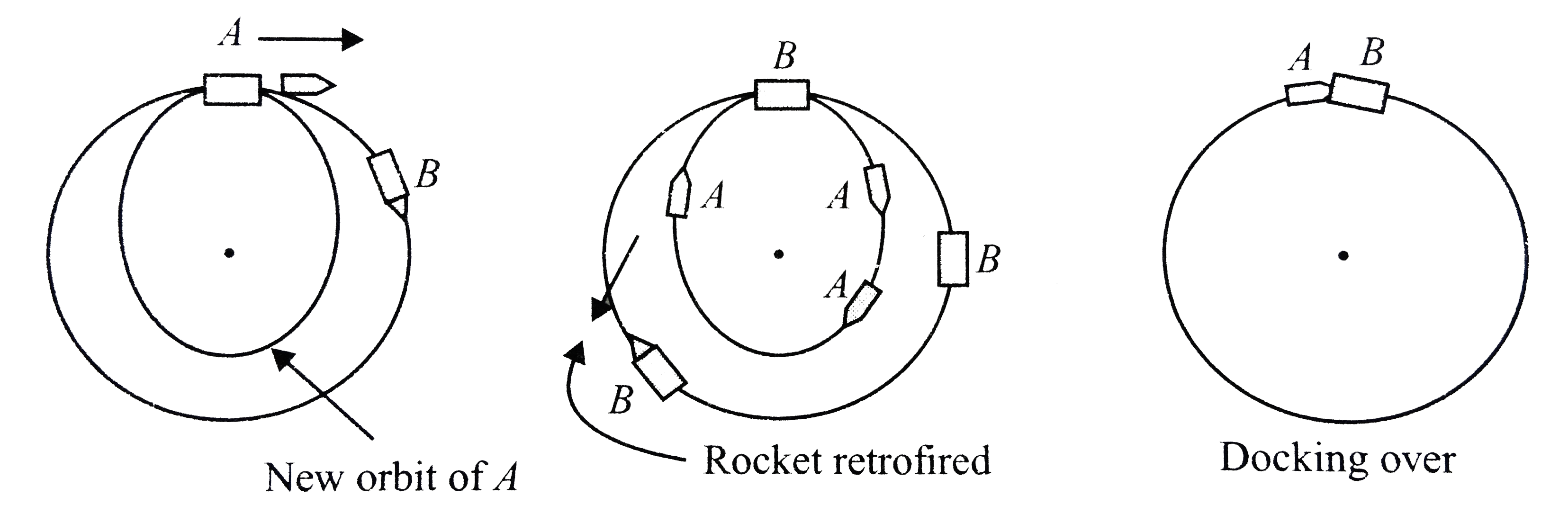
Take mass of the earth =5.98×1024kg
Radius of the earth =6400km
Orbital radius =9600km
Mass of satellite A=320kg
Mass of spacecraft =3200kg
Assume that initially spacecraft B leads satellite A by 100s, i.e., A arrives at any particle position after 100s of B’s arrival. Based on the above information answer the following questions. After once returning to the original point, i.e., the place from where the rockets have been fired, in which direction and with what extent the rockets have to be fired from the satellite to again come back in the original orbit?View Solution

